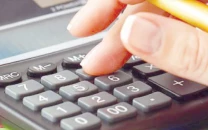Consumers switch to digital banking
Online retail payments surge 84% on changing preferences, tech adoption
1728685990-0/image-(79)1728685990-0-640x480.webp)
Pakistanis are fast migrating to digital banking from cash-based transactions, jacking up the total number of retail payments through online modes to 84% in fiscal year ended June 30, 2024 compared to 76% in the prior year.
According to the State Bank of Pakistan's (SBP) Annual Payment Systems Review – FY24, over the last five years (FY20 to FY24), there has been a significant shift towards digital payments. In FY20, digital payments accounted for 55% of retail payments by volume (the number of transactions), which has now surged to 84%.
The central bank said the rapid growth underscored the accelerating adoption of digital payment methods, reflecting changing consumer preferences and the increasing integration of technology into everyday financial transactions.
"Mobile app-based and internet banking has played a key role in the rise in digital payments. In the last two years, average annual growth of mobile banking has remained around 70% while internet banking around 26%."
Mobile banking apps and internet banking portals have been instrumental in driving the growth of digital payments by offering customers seamless, convenient access to a wide range of banking services 24/7. During FY24, payments through these channels collectively increased by 62% to 1,345.9 million with value rising by 74% to Rs69.8 trillion.
The share of digital payments by value rose to 17% in FY24 compared to 6% in FY20, showing a growth of 11 percentage points in five years.
In other words, big payments were still made through physical banking counters in the form of cash and/or cheques, showing the mistrust of banking customers in technology and cybersecurity.
The currency in circulation rose to Rs9.15 trillion in FY24 compared to Rs8.15 trillion in FY23, up over 12%, or Rs1 trillion, in one year. The money in circulation comes to around 30% of total deposits of Rs30.78 trillion in banks in August 2024.
Cross-border payments
going digital
In addition to increasing trends in the payment ecosystem, FY24 also marked an important milestone in the area of cross-border payments.
The SBP, in partnership with the Arab Monetary Fund (AMF), signed a memorandum of understanding (MoU) to establish a framework of cooperation between Raast, Pakistan's instant payment system, and Buna, the cross-border payment system operated by the Arab Regional Payments Clearing and Settlement Organisation, owned by the AMF.
The Raast and Buna collaboration will help overseas Pakistanis in instantly sending remittances back home through the digital infrastructure, making cross-border transactions easy and convenient.
To recall, a large number of Pakistani expatriates live in the Gulf Arab region. They are a rich source of remittances for their home country. Notable highlights during fiscal year 2023-24 in the performance of payment systems and trends showed that retail payments experienced a remarkable growth, with the volume increasing from 4.7 billion to 6.4 billion and the value rising from Rs403.5 trillion to Rs546.6 trillion, both increasing annually by approximately 35%, the central bank said.
Users of internet banking portals increased by 25%, mobile app banking by 16%, branchless banking mobile app by 2% and notably customers of e-wallets have increased phenomenally by 85%.
Digital wallets issued by branchless banking institutions and Electronic Money Institutions (EMIs) also played an important role in increasing digital payments.
During the fiscal year under review, customers made 2,697 million payments through their branchless banking mobile app wallets and 85.2 million through EMI e-wallets, increasing from 1,704.7 million and 33.3 million, respectively, during FY23.
The value of branchless banking mobile app wallet transactions doubled to Rs8.8 trillion while the value of e-wallet transactions increased threefold to Rs0.23 trillion.
E-commerce payments through wallets/accounts were gaining momentum in contrast to card-based payments. Around 87% of the digital e-commerce payments were initiated through digital wallets/accounts while only 13% were made through payment cards.
Collectively, a total of 308.9 million e-commerce payments were made during the fiscal year with value reaching Rs405.9 billion.
The network of Point-of-Sale (POS) machines expanded to 125,593 with an annual growth of 8.9%, indicating greater support for card-based transactions at retail outlets and stores. As of the end of FY23, there were 85,386 POS-enabled merchants across the country.


















COMMENTS
Comments are moderated and generally will be posted if they are on-topic and not abusive.
For more information, please see our Comments FAQ